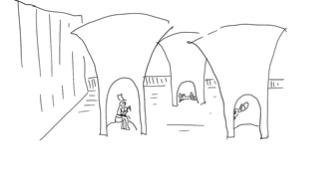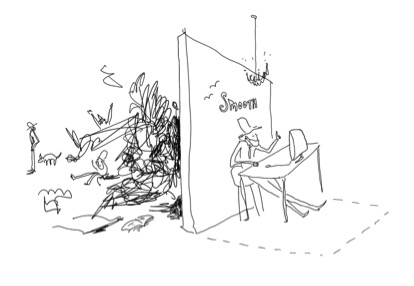Post
#WhenThisIsAllOver | How Can Design Respond? | Buckley Gray Yeoman
6 May 2020
Another look at how things might change post-lockdown. Leading designers of award-winning workplaces, Buckley Gray Yeoman are at the heart of the reconsideration of the changes can be made in workplaces now.
In response to the Government’s restrictions and advice amid the Covid-19 pandemic, all non-essential workplaces stand empty. Where we once gathered in a form of professional communion, there is now only dark emptiness and silence. The workplace has been deemed strictly off-limits, high-risk and inadequate during a crisis.
Trends develop gradually, often picking up momentum until reaching zeitgeist status. This crisis has precipitated a rapid reappraisal of workplace design, and long-term we will see new design trends emerge that will seek to avoid such a punishing shut-down of workplaces should another pandemic emerge. The decades-old debate about the rise of working from home will continue to persist, growing louder until succumbing again to the only home truth: we all like to work in an office.
But at present, anxieties are heightened and the notion of spending whole days in close proximity to hundreds of others has increased concerns, so what immediate changes might be made?
Say hello, wave goodbye
Every reception area is the heart of a contemporary workplace where visitors and tenants coalesce on neutral ground. Their design is always high-quality and demonstrative of the building as a whole, setting the tone for the workplaces above and reflecting the ambitions of the building’s owner.
How might they adapt quickly to alleviate new concerns about proximity and hygiene?
Sensor technology on automatic doors, sign-in screens and elevators could allow for both uninterrupted and contact-free entry into the building. This would also reassess the need for full- time front-of-house staff.
Returning visitors would have quick and established access through a mobile-phone app which makes use of the same contactless technology used for touch-free card payments. Developed by the building’s owner, this ‘speedy boarding’ app route allows for security-related communication and loyalty-driven marketing to be sent straightto visitors phones.
Elevators could respond to approaching footsteps and be voice-activated, responding to either floor numbers or company names. Waiting room coffee machines could also be voice-detecting, or employ the same mobile contactless technology to deliver your favourite coffee: “Welcome back, Mr Anderson. Your cappuccino is on its way”.
Even modest interventions can acknowledge the changing concerns of visitors: Integrated hand sanitisers within reception desks and beside elevators or escalators remove unsightly plastic bottles and demonstrate the owner’s sincere approach to health and hygiene. Complimentary face masks, gloves and hand sanitiser could be provided for building visitors – branded by the building’s owner or each company.
Working on it
The rapid switch to full-time home working for everyone has answered many unresolved theories: How effectively can we work from home? How distracting are our families? How tempting is it to work in our pyjamas? What should we do with the time saved from commuting? Are we working more?
Each of us have had to find an equilibrium and a method that works for us. We have learnt to use new software and develop patterns of behaviour and etiquette for the next generation of video-calls. Despite all of the new novelties, one thing remains clear: We still crave a workplace environment: we are naturally conversational and collaborative beings and benefit from the stimulation and interaction within contemporary workplace environments, even if it is balanced with a certain amount of home working.
We have all read and talked about how workplace trends are likely to emerge that reappraise the existing workplace. But what changes can be made now to ease the transition back into the workplace?
Meeting rooms will see the greatest change – many of which can be made quickly. The large expanse of wall space behind the speaker is a plain canvas which now effectively serves as a billboard for companies: Expect to see this space quickly colonised to convey personality and brand.
Meeting rooms will need to be less claustrophobic and allow for greater space between participants. The quality of video and audio-conference calls will need to be updated fast as the culture of quick ad- hoc team calls already has a feeling of normality and efficiency to it. The design and furnishing of meeting rooms will need to be radically reconsidered, taking into account the appropriate balance of natural and artificial light, whilst acoustic panelling can be installed to provide the best experience for virtual calls. Body positions for online calls tend to be more upright, so finding the ‘right’ chair for long calls will keep staff comfortable when sitting for such a long period of time.
Beyond bog standard
A frank admittance from designers is that one of the most important features of workplace design is one that is often overlooked: the toilets. Free from distraction, its users are a captive audience who may judge the entire design ambition of the building based on the quality and comfort of this space. Manufacturers for this space have already been leaders of sensor technology, but its use is still the exception rather than the trend. Sensor technology for flushing, hand-wash, taps and (often forgotten) doors is an achievable adjustment.
Break away
Previously only featuring in the most ambitious and luxurious of office buildings, open terraces and roof gardens now have a new meaning beyond merely places to take ‘time out’. As the purest form of a ‘breakout space’, these areas allow users to spend time beside planting and water and contribute to mental wellbeing. Moreover, they serve as an important place for time away from the close proximity of others within typical office spaces.
Even modest terrace spaces with boxed planting allow for moment away to relax and enjoy fresh air. Here, peaceful and solitary moments can be found using outdoor furniture which subtly divides space without appearing regimented, thus developing a division of space akin to business class flight cabins – where a large group share a single area yet feel as if they have their own private space. When concerns over outdoor group gatherings loosen and a terrace is large enough, it can provide space for group exercise classes and corporate events, where guests may wish to be less close to one than at the interior gatherings of yesterday.
Leaving
The rise of the secure, internal bike shed is fairly commonplace and in many refurbished buildings they have replaced spaces previously assigned to car parking. Was this a mistake? With electric cars and charging points satisfying environmental concerns, will the privacy and solitary nature of car travel make a comeback in lieu of the perceived exposure within public transport?
It’s clear that whether we walk, cycle, or drive, we need to get back into the workplace soon.
WhenThisIsAllOver is the London Society's debate about what the post-virus, post-lockdown world will and should look like. Contributions so far include:
- Chris Williamson | Weston Williamson + Partners | Change is needed
- Clare Richards | ft'work | Local is central
- James Raynor | Grosvenor Britain and Ireland | We need system change
- Freddy Mardlin | London’s Outside Space
- Andrew Beharrell | Pollard Thomas Edwards | Reevaluation
- Amy Warner | Appreciate More
- Mike Stiff | Stiff + Trevillion
- Lord Toby Harris | London will need fresh purpose
- Matt Brown | How should we commemorate the heroes?
- Peter Murray in conversation with Robert Elms
- Prof. Samer Bagaeen | Create a resilient economy
- Neil Bennett | Farrells | High Streets must Act or Die
- Buckley Gray Yeoman | How can design respond?
- Alistair Barr | Bring production back to the West End
- David Morley | There's only one Way
- Chris Williamson | Getting back to work
- Nicholas Falk | URBED | The suburban battle grounds
- Roland Karthaus | Matter Architecture | Institutional architecture in a time of crisis
- Jonathan Manns | Rockwell Property | Planning for #WhenThisIsAllOver
Please give your views in the comments below, or by emailing blog@londonsociety.org.uk

